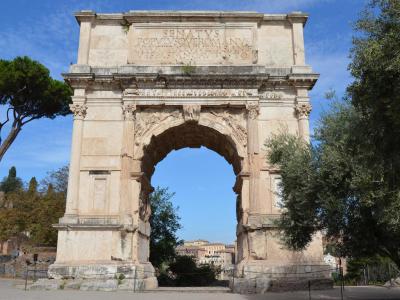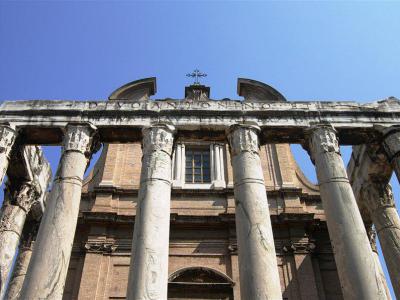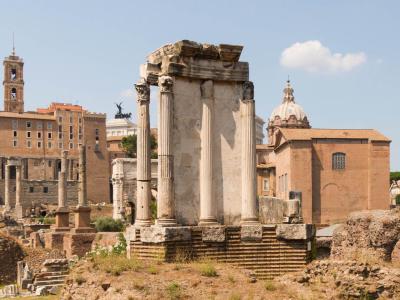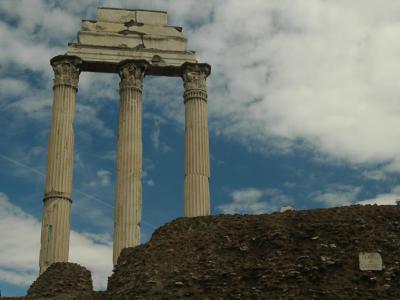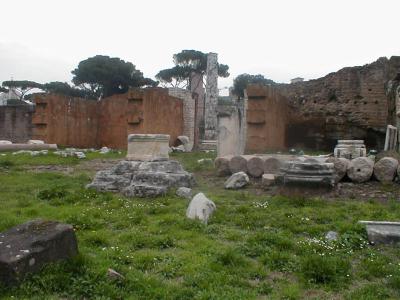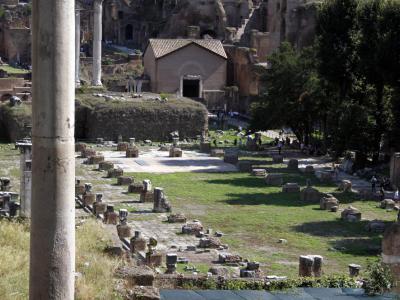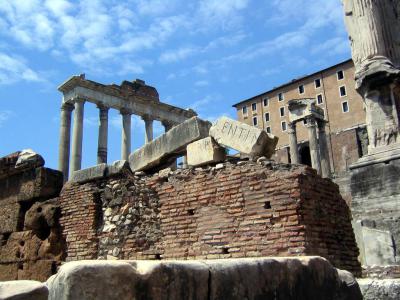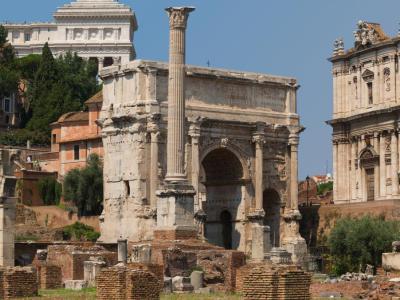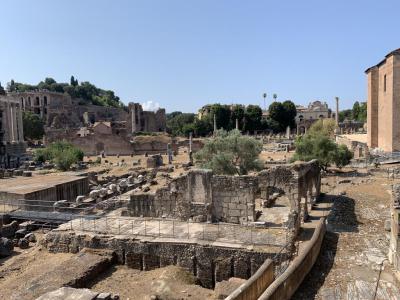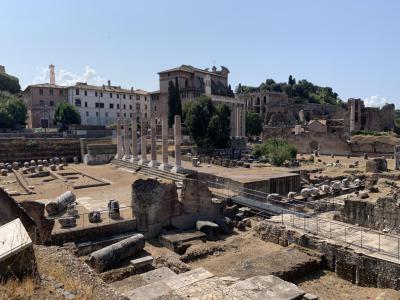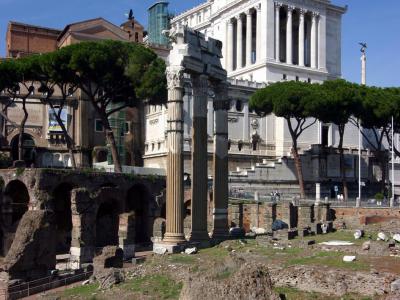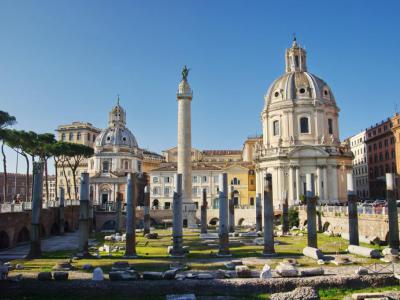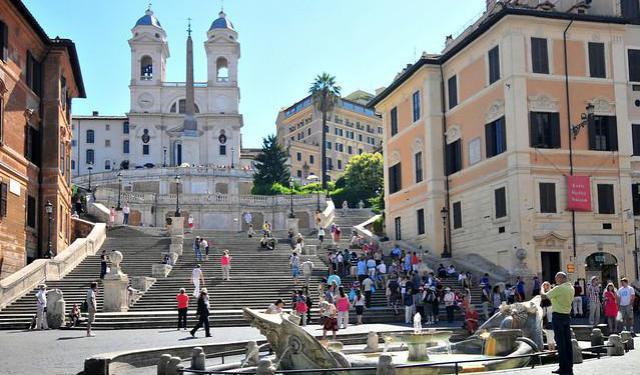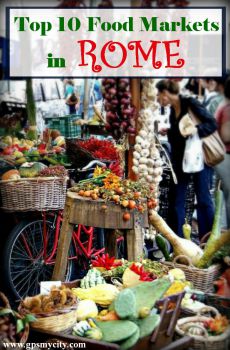Audio Guide: Roman Forum and Imperial Forums Walking Tour (Self Guided), Rome
t's a known fact that Rome wasn't built in a day. But since it was built, the city has stood the test of time and become "eternal." A popular proverb says, "all roads lead to Rome," but very few realize that, inside Rome itself, all roads lead to the Forum.
Indeed, the central hub of ancient Rome, the Roman Forum and the Imperial Forums once served as the city's commercial, civic, and religious core for over a thousand years.
The area's development is believed to have started around the 7th century BC, during the Roman Kingdom. Under the Roman Republic, the Forum became a heart of governance and a venue for public speeches, elections, and trials. As such, it contained important structures, such as the Senate House, basilicas, and temples dedicated to various gods and goddesses, as well as triumphal arches commemorating military victories.
Some notable buildings within the Forum include the Temple of Saturn, the Temple of Vesta, the Arch of Septimius Severus, and the Rostra platform for public orations. Over the centuries, the Forum witnessed numerous historic events, such as the funeral of Julius Caesar and the triumphal processions of victorious Roman generals.
During the late republican and subsequent imperial periods, a series of new squares (known as forums) were added. The first of them was that of Julius Caesar, an ambitious general, who ultimately became the dictator of Rome. The successive emperors, such as Augustus and Nerva, followed suit by glorifying themselves and their achievements in the forums of their own. These came to be known as Imperial Forums. The most grandiose of them was the Forum of Trajan.
Both the Roman and the Imperial Forums were gradually abandoned and fell into disrepair following the decline of the Roman Empire. Still, today their ruins serve as popular tourist sights, topping the list of must-see attractions that offer a glimpse into the grandeur and splendor of ancient Rome.
"The Forum speaks," they say, meaning that the ruins of the Roman Forum have a story to tell anyone who seeks insights into the past. Nonetheless, albeit a highlight on the tourist trail of Rome, the Forum can be a baffling disappointment for visitors as it lacks due signage and information. In this respect, you'll be much better off if visit it armed with a GPSmyCity self-guided mobile app.
Indeed, the central hub of ancient Rome, the Roman Forum and the Imperial Forums once served as the city's commercial, civic, and religious core for over a thousand years.
The area's development is believed to have started around the 7th century BC, during the Roman Kingdom. Under the Roman Republic, the Forum became a heart of governance and a venue for public speeches, elections, and trials. As such, it contained important structures, such as the Senate House, basilicas, and temples dedicated to various gods and goddesses, as well as triumphal arches commemorating military victories.
Some notable buildings within the Forum include the Temple of Saturn, the Temple of Vesta, the Arch of Septimius Severus, and the Rostra platform for public orations. Over the centuries, the Forum witnessed numerous historic events, such as the funeral of Julius Caesar and the triumphal processions of victorious Roman generals.
During the late republican and subsequent imperial periods, a series of new squares (known as forums) were added. The first of them was that of Julius Caesar, an ambitious general, who ultimately became the dictator of Rome. The successive emperors, such as Augustus and Nerva, followed suit by glorifying themselves and their achievements in the forums of their own. These came to be known as Imperial Forums. The most grandiose of them was the Forum of Trajan.
Both the Roman and the Imperial Forums were gradually abandoned and fell into disrepair following the decline of the Roman Empire. Still, today their ruins serve as popular tourist sights, topping the list of must-see attractions that offer a glimpse into the grandeur and splendor of ancient Rome.
"The Forum speaks," they say, meaning that the ruins of the Roman Forum have a story to tell anyone who seeks insights into the past. Nonetheless, albeit a highlight on the tourist trail of Rome, the Forum can be a baffling disappointment for visitors as it lacks due signage and information. In this respect, you'll be much better off if visit it armed with a GPSmyCity self-guided mobile app.
How it works: Download the app "GPSmyCity: Walks in 1K+ Cities" from Apple App Store or Google Play Store to your mobile phone or tablet. The app turns your mobile device into a personal tour guide and its built-in GPS navigation functions guide you from one tour stop to next. The app works offline, so no data plan is needed when traveling abroad.
Roman Forum and Imperial Forums Walking Tour Map
Guide Name: Roman Forum and Imperial Forums Walking Tour
Guide Location: Italy » Rome (See other walking tours in Rome)
Guide Type: Self-guided Walking Tour (Sightseeing)
# of Attractions: 18
Tour Duration: 2 Hour(s)
Travel Distance: 2.0 Km or 1.2 Miles
Author: DanaOffice
Sight(s) Featured in This Guide:
Guide Location: Italy » Rome (See other walking tours in Rome)
Guide Type: Self-guided Walking Tour (Sightseeing)
# of Attractions: 18
Tour Duration: 2 Hour(s)
Travel Distance: 2.0 Km or 1.2 Miles
Author: DanaOffice
Sight(s) Featured in This Guide:
- Arco di Tito (Arch of Titus)
- Via Sacra (Sacred Street)
- Tempio di Romolo (Temple of Romulus)
- Tempio di Antonino e Faustina (Temple of Antoninus and Faustina)
- Tempio di Vesta (Temple of Vesta)
- Tempio dei Dioscuri (Temple of Castor and Pollux)
- Tempio del Divo Giulio (Temple of Deified Julius)
- Basilica Emilia (Basilica Aemilia)
- Basilica Giulia (Basilica Julia)
- Rostri (Rostra Platform)
- Tempio di Saturno (Temple of Saturn)
- Umbilicus Urbis Romae (Navel of the City of Rome)
- Arco di Settimio Severo (Arch of Septimius Severus)
- Curia Julia (Julian Senate House)
- Foro di Nerva (Forum of Nerva)
- Tempio della Pace (Temple of Peace)
- Foro di Cesare (Forum of Caesar)
- Foro di Traiano (Trajan's Forum)
1) Arco di Tito (Arch of Titus)
The Arch of Titus, an honorific arch on the Sacred Street, was built by Emperor Domitian around 81 AD. Its purpose was to commemorate Domitian's brother Titus’ victory in Judaea (which is modern-day Israel and Palestine) and his subsequent deification. The arch celebrates the Roman triumph over the Jewish revolt (also known as the Great Revolt), which resulted in the fall of Jerusalem in 70 AD. This victory brought over 60,000 Jewish slaves and immense wealth back to Rome, funding the construction of the Colosseum.
One of the only three surviving arches out of Rome’s original 36, the Arch of Titus provides a rare visual representation of the Roman triumphal procession of 71 AD. It also portrays Titus on horseback, symbolizing Rome’s dominance, and the Eagle, a representation of Roman power.
The Roman treatment of conquered people varied. Those who surrendered quickly were often incorporated into Roman society, while those who resisted fiercely-as in Judaea-faced brutal consequences such as mass slaughter, enslavement, and destruction of homes and livelihoods. The Jewish rebellion was crushed after the Romans breached three walls of Jerusalem over seven months, leading to one of the most devastating sackings of antiquity.
The arch's panels vividly depict scenes from this momentous event, offering one of the few contemporary representations of artifacts from Herod's Temple including the menorah, a multi-branched candelabra, used in the religious rituals of Judaism. While not explicitly mentioned, the panels closely mirror the narrative of the Roman procession described a decade earlier in the book titled "The Jewish War" written by Josephus, a first-century Roman-Jewish historian.
Beyond its historical importance, the Arch of Titus showcases a significant evolution in Roman art. The reliefs inside demonstrate early illusionistic techniques, giving a sense of depth and motion, a precursor to Baroque aesthetics nearly 1,500 years later. These artistic innovations highlight the stark contrast between the flourishing Roman Empire and the struggling tribes of northern Europe, who at the time still lived in primitive conditions.
As such, the arch had a long-lasting architectural influence, serving as a model for later triumphal arches, including the Arch of Triumph in Paris. Although the identity of its architect is uncertain, Rabirius, a favored designer of Emperor Domitian, is often suggested.
For Jewish communities, the arch remains a symbol of the diaspora. The menorah relief, a significant Jewish artifact depicted on the arch, later inspired the official emblem of the State of Israel. Today, the Arch of Titus is a must-see monument in Rome, linking the ancient past to modern history and symbolizing both Roman power and Jewish resilience.
One of the only three surviving arches out of Rome’s original 36, the Arch of Titus provides a rare visual representation of the Roman triumphal procession of 71 AD. It also portrays Titus on horseback, symbolizing Rome’s dominance, and the Eagle, a representation of Roman power.
The Roman treatment of conquered people varied. Those who surrendered quickly were often incorporated into Roman society, while those who resisted fiercely-as in Judaea-faced brutal consequences such as mass slaughter, enslavement, and destruction of homes and livelihoods. The Jewish rebellion was crushed after the Romans breached three walls of Jerusalem over seven months, leading to one of the most devastating sackings of antiquity.
The arch's panels vividly depict scenes from this momentous event, offering one of the few contemporary representations of artifacts from Herod's Temple including the menorah, a multi-branched candelabra, used in the religious rituals of Judaism. While not explicitly mentioned, the panels closely mirror the narrative of the Roman procession described a decade earlier in the book titled "The Jewish War" written by Josephus, a first-century Roman-Jewish historian.
Beyond its historical importance, the Arch of Titus showcases a significant evolution in Roman art. The reliefs inside demonstrate early illusionistic techniques, giving a sense of depth and motion, a precursor to Baroque aesthetics nearly 1,500 years later. These artistic innovations highlight the stark contrast between the flourishing Roman Empire and the struggling tribes of northern Europe, who at the time still lived in primitive conditions.
As such, the arch had a long-lasting architectural influence, serving as a model for later triumphal arches, including the Arch of Triumph in Paris. Although the identity of its architect is uncertain, Rabirius, a favored designer of Emperor Domitian, is often suggested.
For Jewish communities, the arch remains a symbol of the diaspora. The menorah relief, a significant Jewish artifact depicted on the arch, later inspired the official emblem of the State of Israel. Today, the Arch of Titus is a must-see monument in Rome, linking the ancient past to modern history and symbolizing both Roman power and Jewish resilience.
2) Via Sacra (Sacred Street)
The Sacred Street, once the main ceremonial and religious road in ancient Rome, dates back to the city's regal age. It used to link key settlements, such as Velia, to major landmarks like the Roman Forum and Capitoline Hill. As Rome grew, the street became central to both political and religious activities, passing through significant sites such as the Regia, one of the oldest buildings in the Forum, and the Comitium, the city's political hub.
The name “Sacred” derives from its association with sacred events, including the peace treaty which united the Romans and Sabines under a dual kingship of Romulus and Titus Tatius. Over time, the road was paved and modified, becoming the primary route for triumphal processions celebrating military victories. These parades, which frequently followed Roman conquests, moved through the Arch of Titus and concluded at the Arch of Septimius Severus.
As the street’s importance grew, it underwent improvements, including the addition of colonnades and other architectural enhancements. The Arch of Titus was among these significant upgrades. Over the centuries, the Sacred Street evolved from a residential area, where noble families once lived, into a monumental corridor lined with structures like the Basilica of Maxentius, the Temple of Venus and Roma, and the Temple of Peace. Its proximity to early Christian churches underscored its continued religious significance even as Rome transitioned into the imperial era.
Following the Great Fire of Rome in 64 AD, Nero redirected and straightened the eastern stretch of the street, adding colonnades and commercial spaces, effectively transforming it into a grand boulevard. In this capacity, the road was a stage for everyday Roman life, hosting solemn festivals, public gatherings, business dealings, and even prostitution.
Since the reign of Augustus, the first Roman emperor, it became part of the apotheosis ceremonies for deceased rulers; their bodies were carried along the street to the Forum for public tributes.
Visitors can still see wear and tear from Roman times on the Sacred Street's pavers, including smooth surfaces and wagon-wheel crevices. As such, it's a must-see highlight of the Roman Forum, offering a tangible connection to Rome’s ancient grandeur.
The name “Sacred” derives from its association with sacred events, including the peace treaty which united the Romans and Sabines under a dual kingship of Romulus and Titus Tatius. Over time, the road was paved and modified, becoming the primary route for triumphal processions celebrating military victories. These parades, which frequently followed Roman conquests, moved through the Arch of Titus and concluded at the Arch of Septimius Severus.
As the street’s importance grew, it underwent improvements, including the addition of colonnades and other architectural enhancements. The Arch of Titus was among these significant upgrades. Over the centuries, the Sacred Street evolved from a residential area, where noble families once lived, into a monumental corridor lined with structures like the Basilica of Maxentius, the Temple of Venus and Roma, and the Temple of Peace. Its proximity to early Christian churches underscored its continued religious significance even as Rome transitioned into the imperial era.
Following the Great Fire of Rome in 64 AD, Nero redirected and straightened the eastern stretch of the street, adding colonnades and commercial spaces, effectively transforming it into a grand boulevard. In this capacity, the road was a stage for everyday Roman life, hosting solemn festivals, public gatherings, business dealings, and even prostitution.
Since the reign of Augustus, the first Roman emperor, it became part of the apotheosis ceremonies for deceased rulers; their bodies were carried along the street to the Forum for public tributes.
Visitors can still see wear and tear from Roman times on the Sacred Street's pavers, including smooth surfaces and wagon-wheel crevices. As such, it's a must-see highlight of the Roman Forum, offering a tangible connection to Rome’s ancient grandeur.
3) Tempio di Romolo (Temple of Romulus)
The Temple of Romulus, wedged between the Temple of Antoninus and Faustina and the Basilica of Maxentius along the Sacred Street, is traditionally linked to Valerius Romulus, the son of Emperor Maxentius. However, its true origins remain debated.
Some historians suggest that it originally served as a vestibule for the Temple of Peace, later repurposed by Maxentius, in the 4th century AD, as a temple honoring his son, who died in the year 309 at the tender age of four. Medieval sources and coins inscribed with “in eternal memory” phrase support this theory, though some argue the inscription may refer to a mausoleum on the Appian Way. Others claim the temple was dedicated to Constantine I.
A 19th-century theory proposes that the structure was once linked to the Temple of the Penates, which stood on the Velia Hill and, according to legend, was founded by Romulus, the mythical founder of Rome. Regardless of its origins, the temple was later incorporated into a Christian complex when Pope Felix IV converted part of it into the Basilica of Saints Cosmas and Damian in 527 AD. Over time, the structure underwent several modifications.
Architecturally, the circular temple is notable for its brick construction, concrete dome, and a façade that originally featured four statues. Its most striking feature still in place is the grand entrance, framed by two red porphyry columns, a material considered as valuable as gold in antiquity. Among its most remarkable elements is the original bronze doors, a rare surviving example from ancient Rome, still functioning with their original locking mechanism. Inside, a central circular hall is flanked by two symmetrical apsidal halls, maintaining a harmonious layout.
Despite centuries of change, the Temple of Divine Romulus remains one of the best-preserved structures in the Roman Forum.
Some historians suggest that it originally served as a vestibule for the Temple of Peace, later repurposed by Maxentius, in the 4th century AD, as a temple honoring his son, who died in the year 309 at the tender age of four. Medieval sources and coins inscribed with “in eternal memory” phrase support this theory, though some argue the inscription may refer to a mausoleum on the Appian Way. Others claim the temple was dedicated to Constantine I.
A 19th-century theory proposes that the structure was once linked to the Temple of the Penates, which stood on the Velia Hill and, according to legend, was founded by Romulus, the mythical founder of Rome. Regardless of its origins, the temple was later incorporated into a Christian complex when Pope Felix IV converted part of it into the Basilica of Saints Cosmas and Damian in 527 AD. Over time, the structure underwent several modifications.
Architecturally, the circular temple is notable for its brick construction, concrete dome, and a façade that originally featured four statues. Its most striking feature still in place is the grand entrance, framed by two red porphyry columns, a material considered as valuable as gold in antiquity. Among its most remarkable elements is the original bronze doors, a rare surviving example from ancient Rome, still functioning with their original locking mechanism. Inside, a central circular hall is flanked by two symmetrical apsidal halls, maintaining a harmonious layout.
Despite centuries of change, the Temple of Divine Romulus remains one of the best-preserved structures in the Roman Forum.
4) Tempio di Antonino e Faustina (Temple of Antoninus and Faustina)
What's known today as the Church of San Lorenzo in Miranda in the Roman Forum was adapted from the ancient Temple of Antoninus and Faustina. Like many other churches in Rome, this one was built over an older structure, reflecting the city's characteristic blend of ancient and modern layers. Although much of the structure has been modified over time, the original portico with its marble Corinthian columns remains intact.
Emperor Antoninus Pius, one of Rome’s so-called “Five Good Emperors”, built the temple in 141 AD to honor his deceased wife, Faustina the Elder, whom he deified. This marked the first time an empress was granted a permanent presence in the Roman Forum. After Antoninus Pius died in 161 AD, his successor, Marcus Aurelius, rededicated the temple to honor the imperial couple.
The structure was built on a high podium with an inscription on the façade declaring its dedication to the “divine Antoninus and Faustina” by order of the Senate. The portico, supported by eight massive Corinthian columns (each standing 17 meters tall), is the most striking feature, while its frieze, adorned with griffins, acanthus scrolls, and candelabra, later influenced Renaissance and Neoclassical art.
Coins from the era suggest the temple originally had a gated entrance from the Sacred Street and housed statues of Faustina and Antoninus Pius, fragments of which were later discovered. By the 7th century, the temple was converted into a Christian church, renamed after Saint Lawrence, based on the belief that his sentencing took place there. Over time, medieval modifications included attempts to dismantle the columns for materials and the removal of much of the temple’s original marble facing.
In the 15th century, Pope Martin V granted the church to the Guild of Apothecaries, which still operates a small museum nearby. During Emperor Charles V’s visit in 1536, parts of the church were demolished to restore the temple’s classical elements. Later, in 1602, renovations gave the church a single nave and three chapels, with notable artworks like Pietro da Cortona’s “Martyrdom of Saint Lawrence” and Domenichino’s “Madonna and Child with Saints.”
Today, the Church of San Lorenzo in Miranda represents a remarkable fusion of Roman antiquity and Catholic tradition, symbolizing Rome’s layered history within its ancient walls.
Emperor Antoninus Pius, one of Rome’s so-called “Five Good Emperors”, built the temple in 141 AD to honor his deceased wife, Faustina the Elder, whom he deified. This marked the first time an empress was granted a permanent presence in the Roman Forum. After Antoninus Pius died in 161 AD, his successor, Marcus Aurelius, rededicated the temple to honor the imperial couple.
The structure was built on a high podium with an inscription on the façade declaring its dedication to the “divine Antoninus and Faustina” by order of the Senate. The portico, supported by eight massive Corinthian columns (each standing 17 meters tall), is the most striking feature, while its frieze, adorned with griffins, acanthus scrolls, and candelabra, later influenced Renaissance and Neoclassical art.
Coins from the era suggest the temple originally had a gated entrance from the Sacred Street and housed statues of Faustina and Antoninus Pius, fragments of which were later discovered. By the 7th century, the temple was converted into a Christian church, renamed after Saint Lawrence, based on the belief that his sentencing took place there. Over time, medieval modifications included attempts to dismantle the columns for materials and the removal of much of the temple’s original marble facing.
In the 15th century, Pope Martin V granted the church to the Guild of Apothecaries, which still operates a small museum nearby. During Emperor Charles V’s visit in 1536, parts of the church were demolished to restore the temple’s classical elements. Later, in 1602, renovations gave the church a single nave and three chapels, with notable artworks like Pietro da Cortona’s “Martyrdom of Saint Lawrence” and Domenichino’s “Madonna and Child with Saints.”
Today, the Church of San Lorenzo in Miranda represents a remarkable fusion of Roman antiquity and Catholic tradition, symbolizing Rome’s layered history within its ancient walls.
5) Tempio di Vesta (Temple of Vesta)
The Temple of Vesta was a central religious site in ancient Rome. Unlike most temples, it did not house a cult statue but instead contained an eternal flame, symbolizing the city’s security and prosperity. This flame was tended by the Vestal Virgins, priestesses devoted to the goddess Vesta, protector of the hearth and home. The temple’s circular design, inspired by early Roman homes, classified it as a tholos, with a central hearth where the sacred fire burned.
Tradition attributes the temple’s foundation to Numa Pompilius, Rome’s second king, in the 7th century BC. Numa also established the House of the Vestal Virgins, appointing the first two priestesses, a number that later grew to six. These young women, chosen from noble families, took a 30-year vow of chastity, and any failure in their duties or violations of their vows could result in severe punishments, including live burial. However, the Vestals also wielded considerable influence, with the power to free slaves and prisoners. Harming them was a crime punishable by death.
The temple’s architecture evolved over centuries, incorporating Greek influences, particularly its 20 fluted Corinthian columns, a marble podium, and a wide staircase leading to an interior chamber with an 8.6-meter diameter. It was also believed to house sacred relics, including the Palladium, a divine image said to protect Rome.
Over the centuries, the Temple of Vesta suffered multiple fires and reconstructions. It was first destroyed during the Gallic invasion in 390 BC, but the Vestals rekindled the flame as a sign of Rome’s resilience. Fires in 241 BC, 210 BC, and the 1st century BC led to further rebuilding, notably by emperors Augustus and Nero. After another major fire in 191 AD, Julia Domna, wife of Septimius Severus, oversaw its last significant restoration. In 394 AD, Emperor Theodosius I ordered its closure, marking the end of the Vestal order as Christianity became the empire’s dominant faith.
The Renaissance dealt another blow to the temple, seeing its marble repurposed for churches and palaces in 1549. What remains today is a reconstruction from the 1930s during Mussolini’s excavations of the Forum. Behind the ruins stands the House of the Vestal Virgins, leading up to the Palatine Hill. While often called a temple, in Roman religious tradition, it was considered a shrine, rather than a full-fledged temple.
Tradition attributes the temple’s foundation to Numa Pompilius, Rome’s second king, in the 7th century BC. Numa also established the House of the Vestal Virgins, appointing the first two priestesses, a number that later grew to six. These young women, chosen from noble families, took a 30-year vow of chastity, and any failure in their duties or violations of their vows could result in severe punishments, including live burial. However, the Vestals also wielded considerable influence, with the power to free slaves and prisoners. Harming them was a crime punishable by death.
The temple’s architecture evolved over centuries, incorporating Greek influences, particularly its 20 fluted Corinthian columns, a marble podium, and a wide staircase leading to an interior chamber with an 8.6-meter diameter. It was also believed to house sacred relics, including the Palladium, a divine image said to protect Rome.
Over the centuries, the Temple of Vesta suffered multiple fires and reconstructions. It was first destroyed during the Gallic invasion in 390 BC, but the Vestals rekindled the flame as a sign of Rome’s resilience. Fires in 241 BC, 210 BC, and the 1st century BC led to further rebuilding, notably by emperors Augustus and Nero. After another major fire in 191 AD, Julia Domna, wife of Septimius Severus, oversaw its last significant restoration. In 394 AD, Emperor Theodosius I ordered its closure, marking the end of the Vestal order as Christianity became the empire’s dominant faith.
The Renaissance dealt another blow to the temple, seeing its marble repurposed for churches and palaces in 1549. What remains today is a reconstruction from the 1930s during Mussolini’s excavations of the Forum. Behind the ruins stands the House of the Vestal Virgins, leading up to the Palatine Hill. While often called a temple, in Roman religious tradition, it was considered a shrine, rather than a full-fledged temple.
6) Tempio dei Dioscuri (Temple of Castor and Pollux)
The Temple of Castor and Pollux in the Roman Forum was dedicated to the Dioscuri, twin sons of the god Jupiter (also known as Zeus) and the mortal woman Leda. The brothers were known for their horsemanship, military skill, and loyalty.
The cult of Castor and Pollux was introduced to Rome from Greece, and their temple was originally constructed to commemorate the Roman victory at the Battle of Lake Regillus in 495 BC. According to legend, the twins miraculously appeared on the battlefield, fighting for the Romans. After the battle, they were seen watering their horses at the Spring of Juturna in the Forum, thus marking the spot where their temple was built later. The temple was officially dedicated on July 15, 484 BC.
The Dioscuri symbolized Roman virtues such as courage, loyalty, and strength, making them ideal patrons for the Roman knights (called “equites”). Their blond, curly hair and white horses further contributed to their association with youthful vigor and military prowess.
Throughout the Republican period, the temple served various civic functions, including as a meeting place for the Senate and a speaker’s platform. Later, under the Imperial period, it became a center for official government functions, the State treasury, and weights and measures regulation. Evidence even suggests that one of its chambers may have been used by a dentist.
Over time, the temple underwent several reconstructions. The first major renovation occurred in 117 BC after a military victory over the Dalmatians. After being destroyed by fire in 14 BC, it was rebuilt by Tiberius, the adopted son of Emperor Augustus, and was rededicated in 6 AD. This version, featuring Corinthian columns and a large podium, is the one whose remains are visible today. During the Imperial era, Castor and Pollux were closely associated with the imperial family, particularly with Gaius and Lucius Caesar, as well as Tiberius and Drusus.
By the 4th century AD, the temple was likely falling into disrepair as Christianity replaced pagan worship. By the 15th century, only three Corinthian columns remained standing, leading to the nearby street being nicknamed "The Road of Three Pillars." In 1760, preservation efforts were made to prevent their collapse.
Today, the three towering columns and remains of the podium make the Temple of Castor and Pollux one of the most recognizable ruins in the Roman Forum. Though the temple itself is mostly gone, statues of the Dioscuri still stand in Campidoglio Square, guarding the steps leading up to Capitoline Hill.
The cult of Castor and Pollux was introduced to Rome from Greece, and their temple was originally constructed to commemorate the Roman victory at the Battle of Lake Regillus in 495 BC. According to legend, the twins miraculously appeared on the battlefield, fighting for the Romans. After the battle, they were seen watering their horses at the Spring of Juturna in the Forum, thus marking the spot where their temple was built later. The temple was officially dedicated on July 15, 484 BC.
The Dioscuri symbolized Roman virtues such as courage, loyalty, and strength, making them ideal patrons for the Roman knights (called “equites”). Their blond, curly hair and white horses further contributed to their association with youthful vigor and military prowess.
Throughout the Republican period, the temple served various civic functions, including as a meeting place for the Senate and a speaker’s platform. Later, under the Imperial period, it became a center for official government functions, the State treasury, and weights and measures regulation. Evidence even suggests that one of its chambers may have been used by a dentist.
Over time, the temple underwent several reconstructions. The first major renovation occurred in 117 BC after a military victory over the Dalmatians. After being destroyed by fire in 14 BC, it was rebuilt by Tiberius, the adopted son of Emperor Augustus, and was rededicated in 6 AD. This version, featuring Corinthian columns and a large podium, is the one whose remains are visible today. During the Imperial era, Castor and Pollux were closely associated with the imperial family, particularly with Gaius and Lucius Caesar, as well as Tiberius and Drusus.
By the 4th century AD, the temple was likely falling into disrepair as Christianity replaced pagan worship. By the 15th century, only three Corinthian columns remained standing, leading to the nearby street being nicknamed "The Road of Three Pillars." In 1760, preservation efforts were made to prevent their collapse.
Today, the three towering columns and remains of the podium make the Temple of Castor and Pollux one of the most recognizable ruins in the Roman Forum. Though the temple itself is mostly gone, statues of the Dioscuri still stand in Campidoglio Square, guarding the steps leading up to Capitoline Hill.
7) Tempio del Divo Giulio (Temple of Deified Julius)
The Temple of Deified Julius, also called the Temple of Caesar, is a significant monument in the Roman Forum, built to honor Julius Caesar. Situated near the Regia and Temple of Vesta, it once stood as the focal point of the Forum, symbolizing the power of the emerging Roman Empire.
Although Julius Caesar was never officially an emperor-that title went to his adopted son Augustus-his actions led to the Republic’s collapse. His appointment as dictator for life alarmed the Roman aristocracy and ultimately led to his assassination. The ensuing political turmoil resulted in the rise of the Empire. The temple was part of this transition, reinforcing the new regime’s authority. Many who had supported Caesar’s murder later backed the temple’s construction, likely to align themselves with the public’s admiration for him.
Caesar became the first Roman to be deified after death and the first to be buried in the Forum. His cremation in 44 BC was spontaneous, happening in the Forum rather than the planned Field of Mars. Given that Roman laws prohibited burials within city limits for hygienic reasons, this was an exceptional honor. A temporary shrine soon emerged at the cremation site, drawing widespread public devotion. Recognizing the significance of Caesar’s deification, the Senate officially decreed the temple in 42 BC, and Augustus dedicated it on August 18, 29 BC.
The temple became a central political and religious landmark. Its high podium doubled as a speaker’s platform, decorated with ship prows taken as war trophies. It hosted imperial speeches, funerary eulogies, and political declarations, further cementing Augustus’s connection to his divine predecessor. A festival in Augustus’s honor was held here every four years, reinforcing his status.
Architecturally, the temple mirrored the Temple of Venus Genetrix, emphasizing the Julian family’s divine lineage. Scholars debate whether its columns followed Corinthian, Ionic, or Composite styles. A key symbol of Caesar’s deification was Caesar’s Comet, which appeared for seven days after his death. Augustus seized on this celestial event, using it to promote Caesar’s divine status and incorporating a star motif into the temple’s decoration.
By the 15th century, much of the temple’s materials had been repurposed for other buildings, leaving only cement foundations. Today, it remains a historically significant site, with visitors still leaving offerings at Caesar’s altar, especially on March 15, the anniversary of his assassination.
Although Julius Caesar was never officially an emperor-that title went to his adopted son Augustus-his actions led to the Republic’s collapse. His appointment as dictator for life alarmed the Roman aristocracy and ultimately led to his assassination. The ensuing political turmoil resulted in the rise of the Empire. The temple was part of this transition, reinforcing the new regime’s authority. Many who had supported Caesar’s murder later backed the temple’s construction, likely to align themselves with the public’s admiration for him.
Caesar became the first Roman to be deified after death and the first to be buried in the Forum. His cremation in 44 BC was spontaneous, happening in the Forum rather than the planned Field of Mars. Given that Roman laws prohibited burials within city limits for hygienic reasons, this was an exceptional honor. A temporary shrine soon emerged at the cremation site, drawing widespread public devotion. Recognizing the significance of Caesar’s deification, the Senate officially decreed the temple in 42 BC, and Augustus dedicated it on August 18, 29 BC.
The temple became a central political and religious landmark. Its high podium doubled as a speaker’s platform, decorated with ship prows taken as war trophies. It hosted imperial speeches, funerary eulogies, and political declarations, further cementing Augustus’s connection to his divine predecessor. A festival in Augustus’s honor was held here every four years, reinforcing his status.
Architecturally, the temple mirrored the Temple of Venus Genetrix, emphasizing the Julian family’s divine lineage. Scholars debate whether its columns followed Corinthian, Ionic, or Composite styles. A key symbol of Caesar’s deification was Caesar’s Comet, which appeared for seven days after his death. Augustus seized on this celestial event, using it to promote Caesar’s divine status and incorporating a star motif into the temple’s decoration.
By the 15th century, much of the temple’s materials had been repurposed for other buildings, leaving only cement foundations. Today, it remains a historically significant site, with visitors still leaving offerings at Caesar’s altar, especially on March 15, the anniversary of his assassination.
8) Basilica Emilia (Basilica Aemilia)
The Basilica Aemilia, a grand basilica in the Roman Forum, played a crucial role in ancient Rome’s architectural and civic landscape. Although only traces of its foundation and some reconstructed elements remain today, the basilica’s historical significance endures. Measuring 100 meters in length and 30 meters in width, it featured two rows of 16 arches along its sides and had three main entrances, which contributed to its imposing presence.
The basilica was originally constructed in 179 BC by censor Marcus Fulvius Nobilior and was initially called the Basilica Fulvia. However, after Nobilior’s death, his colleague Marcus Aemilius Lepidus took over the project. Over time, it underwent numerous restorations and embellishments by the Aemilian gens, eventually being renamed Basilica Aemilia. Some scholars, however, debate whether the Basilica Fulvia and Basilica Aemilia were distinct structures.
In 55 BC, the building saw a major reconstruction initiated by Lucius Aemilius Lepidus Paullus, a prominent Roman politician. His son completed the renovation in 34 BC, altering the layout by shortening its length and replacing the back portico with a second nave. This version of the basilica showcased a mix of architectural styles, including African marble Corinthian columns in the central nave, cipolline marble columns in the second row, and Ionic capitals in the outermost row.
In 14 BC, a fire led to extensive restoration efforts under Emperor Augustus, who dedicated a new portico to his grandsons, Gaius and Lucius. The basilica’s upper floors were rebuilt, and its attic was adorned with statues of barbarians, emphasizing the grandeur of Roman victory and culture.
However, the basilica met its demise during the 410 AD sack of Rome by Alaric, the first king of the Visigoths. The fire destroyed the wooden roof, façade, and tabernae, leaving behind melted bronze coins that stained the marble floor with green traces. Although a partial reconstruction followed in 420 AD, using pink granite columns for the portico, an 847 earthquake caused its final collapse. The remaining materials were later repurposed for Renaissance buildings, including the Giraud Torlonia Palace.
Throughout its existence, the Basilica Aemilia underwent multiple modifications that reflected the evolution of Roman architecture. Today, although in ruins, it remains a key part of the Roman Forum’s legacy, offering insight into the grandeur of ancient Rome’s civic and architectural achievements.
The basilica was originally constructed in 179 BC by censor Marcus Fulvius Nobilior and was initially called the Basilica Fulvia. However, after Nobilior’s death, his colleague Marcus Aemilius Lepidus took over the project. Over time, it underwent numerous restorations and embellishments by the Aemilian gens, eventually being renamed Basilica Aemilia. Some scholars, however, debate whether the Basilica Fulvia and Basilica Aemilia were distinct structures.
In 55 BC, the building saw a major reconstruction initiated by Lucius Aemilius Lepidus Paullus, a prominent Roman politician. His son completed the renovation in 34 BC, altering the layout by shortening its length and replacing the back portico with a second nave. This version of the basilica showcased a mix of architectural styles, including African marble Corinthian columns in the central nave, cipolline marble columns in the second row, and Ionic capitals in the outermost row.
In 14 BC, a fire led to extensive restoration efforts under Emperor Augustus, who dedicated a new portico to his grandsons, Gaius and Lucius. The basilica’s upper floors were rebuilt, and its attic was adorned with statues of barbarians, emphasizing the grandeur of Roman victory and culture.
However, the basilica met its demise during the 410 AD sack of Rome by Alaric, the first king of the Visigoths. The fire destroyed the wooden roof, façade, and tabernae, leaving behind melted bronze coins that stained the marble floor with green traces. Although a partial reconstruction followed in 420 AD, using pink granite columns for the portico, an 847 earthquake caused its final collapse. The remaining materials were later repurposed for Renaissance buildings, including the Giraud Torlonia Palace.
Throughout its existence, the Basilica Aemilia underwent multiple modifications that reflected the evolution of Roman architecture. Today, although in ruins, it remains a key part of the Roman Forum’s legacy, offering insight into the grandeur of ancient Rome’s civic and architectural achievements.
9) Basilica Giulia (Basilica Julia)
The Basilica Julia was a grand structure in the heart of the Roman Forum in ancient Rome. This impressive building served as a public space for meetings and official affairs during the Roman Empire. Although now in ruins, the excavated remains provide valuable insights into its architectural design and historical significance.
The Basilica Julia was constructed on the site where the earlier Basilica Sempronia stood, dating back to 170 BC. Positioned along the southern side of the Forum, it faced the Basilica Aemilia. The basilica's initial dedication took place in 46 BC by Julius Caesar, and it was completed by Augustus, who named the edifice after his adoptive father.
Over time, the Basilica Julia suffered the consequences of destructive excavations. In the late 15th and 16th centuries, these were carried out with the primary objective of recovering valuable travertine and marble for reuse. In fact, some of the travertine obtained from the ruins was employed in the facade of the Torlonia Palace, in 1496.
From November 1788 to March 1789, another round of excavations resulted in the dismantling of much of the remaining colored marble pavement and the removal of numerous architectural fragments. Later, in 1850, more excavations were conducted at the site, reconstructing a single marble column and utilizing travertine supports. Also, in 1872, the unearthed segments of concrete vaulting with stuccowork coffering were unfortunately destroyed.
Despite these destructive interventions, the remaining foundations, floors, a small back corner wall with a few arches, and a single column from the first building phase of the Basilica Julia provide valuable glimpses into its past glory. Through careful study and preservation efforts, archaeologists and historians continue to unravel the historical and architectural significance of this magnificent structure in the Roman Forum.
The Basilica Julia was constructed on the site where the earlier Basilica Sempronia stood, dating back to 170 BC. Positioned along the southern side of the Forum, it faced the Basilica Aemilia. The basilica's initial dedication took place in 46 BC by Julius Caesar, and it was completed by Augustus, who named the edifice after his adoptive father.
Over time, the Basilica Julia suffered the consequences of destructive excavations. In the late 15th and 16th centuries, these were carried out with the primary objective of recovering valuable travertine and marble for reuse. In fact, some of the travertine obtained from the ruins was employed in the facade of the Torlonia Palace, in 1496.
From November 1788 to March 1789, another round of excavations resulted in the dismantling of much of the remaining colored marble pavement and the removal of numerous architectural fragments. Later, in 1850, more excavations were conducted at the site, reconstructing a single marble column and utilizing travertine supports. Also, in 1872, the unearthed segments of concrete vaulting with stuccowork coffering were unfortunately destroyed.
Despite these destructive interventions, the remaining foundations, floors, a small back corner wall with a few arches, and a single column from the first building phase of the Basilica Julia provide valuable glimpses into its past glory. Through careful study and preservation efforts, archaeologists and historians continue to unravel the historical and architectural significance of this magnificent structure in the Roman Forum.
10) Rostri (Rostra Platform)
The Rostra was a prominent platform in ancient Rome used for public speeches during the republican and imperial periods. Originally part of the Comitium – the venue for tribal assemblies, – it faced the Senate House and allowed magistrates, politicians, and orators to address assembled citizens. Originally a simple wooden structure, it was built in the 6th century BC. Roman coin depictions suggest it had a circular design with arches and staircases.
The term “Rostra” comes from the Latin word for ship prows. In 338 BC, the platform was decorated with the naval rams from captured ships after the Roman victory at the Battle of Antium.
Beyond political oratory, the Rostra played a darker role in Roman history. It became a site where the severed heads of political enemies, including Cicero, were displayed. Control of the Rostra was significant during the late Republic, with figures like Julius Caesar, Brutus, and Cassius using it to influence public sentiment amid political unrest.
The Rostra also served as a court platform, where magistrates sat in senatorial chairs, overseeing trials while jurors and citizens observed from nearby steps. It was adorned with statues, sundials, and honorary monuments, sometimes removed by Senate decree.
By the imperial period, the "Elder Rostra" was distinguished from later structures bearing the same name. In 44 BC, Caesar created the New Rostra in the Julian Forum. Left unfinished at his death, his successor Augustus completed it as the Rostra Augusti. The remains of it still exist near the Arch of Septimius Severus.
The term “Rostra” comes from the Latin word for ship prows. In 338 BC, the platform was decorated with the naval rams from captured ships after the Roman victory at the Battle of Antium.
Beyond political oratory, the Rostra played a darker role in Roman history. It became a site where the severed heads of political enemies, including Cicero, were displayed. Control of the Rostra was significant during the late Republic, with figures like Julius Caesar, Brutus, and Cassius using it to influence public sentiment amid political unrest.
The Rostra also served as a court platform, where magistrates sat in senatorial chairs, overseeing trials while jurors and citizens observed from nearby steps. It was adorned with statues, sundials, and honorary monuments, sometimes removed by Senate decree.
By the imperial period, the "Elder Rostra" was distinguished from later structures bearing the same name. In 44 BC, Caesar created the New Rostra in the Julian Forum. Left unfinished at his death, his successor Augustus completed it as the Rostra Augusti. The remains of it still exist near the Arch of Septimius Severus.
11) Tempio di Saturno (Temple of Saturn)
The Temple of Saturn, one of the most recognizable ruins in the Roman Forum, stands as a testament to Rome’s ancient religious and financial traditions. Positioned at the base of the Capitoline Hill, near the Arch of Septimius Severus, its surviving columns are an enduring symbol of Rome’s legendary past.
The temple’s origins date back to 497 BC, when it was constructed under the rule of Tarquinius, the last king of Rome, just before the establishment of the Roman Republic. Over the centuries, the structure underwent multiple reconstructions due to fires and other damage. The present ruins belong to a 4th-century AD restoration, as indicated by an inscription on the architrave, which credits the Roman Senate for its rebuilding after a major fire.
Dedicated to Saturn, an ancient Roman deity associated with agriculture, wealth, and abundance, the temple also functioned as Rome’s public treasury. This role lasted throughout the Republican era and continued to some extent under the Empire. Saturn was later equated with the Greek god Kronos, further elevating his significance within Roman religion.
Architecturally, the Temple of Saturn was famous for its grand portico, featuring eight towering Ionic columns that once supported an elaborate pediment and frieze. Though much of the structure has vanished, the architrave inscription remains intact, reading: “The Senate and People of Rome restored what fire had consumed.” This highlights both the temple’s resilience and the collective civic duty of the Roman people.
Beyond its religious and financial roles, the temple played a key part in the Saturnalia festival, held annually on December 17th. This lively event, which later evolved into Christmas traditions, was characterized by role reversals-slaves were temporarily treated as equals to their masters-along with feasting, gift-giving, and general revelry. The festival culminated on December 25th, the Day of the Invincible Sun, marking a transition from Roman to Christian holiday customs.
Over time, the temple also housed a bank, a logical evolution given Saturn’s association with wealth. Today, what remains of this once-grand structure are its podium and eight massive granite and marble columns, offering a glimpse into its former splendor. Though much of the original temple is lost, its historical and cultural significance endures, inviting visitors to imagine its past glory at the heart of ancient Rome.
The temple’s origins date back to 497 BC, when it was constructed under the rule of Tarquinius, the last king of Rome, just before the establishment of the Roman Republic. Over the centuries, the structure underwent multiple reconstructions due to fires and other damage. The present ruins belong to a 4th-century AD restoration, as indicated by an inscription on the architrave, which credits the Roman Senate for its rebuilding after a major fire.
Dedicated to Saturn, an ancient Roman deity associated with agriculture, wealth, and abundance, the temple also functioned as Rome’s public treasury. This role lasted throughout the Republican era and continued to some extent under the Empire. Saturn was later equated with the Greek god Kronos, further elevating his significance within Roman religion.
Architecturally, the Temple of Saturn was famous for its grand portico, featuring eight towering Ionic columns that once supported an elaborate pediment and frieze. Though much of the structure has vanished, the architrave inscription remains intact, reading: “The Senate and People of Rome restored what fire had consumed.” This highlights both the temple’s resilience and the collective civic duty of the Roman people.
Beyond its religious and financial roles, the temple played a key part in the Saturnalia festival, held annually on December 17th. This lively event, which later evolved into Christmas traditions, was characterized by role reversals-slaves were temporarily treated as equals to their masters-along with feasting, gift-giving, and general revelry. The festival culminated on December 25th, the Day of the Invincible Sun, marking a transition from Roman to Christian holiday customs.
Over time, the temple also housed a bank, a logical evolution given Saturn’s association with wealth. Today, what remains of this once-grand structure are its podium and eight massive granite and marble columns, offering a glimpse into its former splendor. Though much of the original temple is lost, its historical and cultural significance endures, inviting visitors to imagine its past glory at the heart of ancient Rome.
12) Umbilicus Urbis Romae (Navel of the City of Rome)
The Navel of the City of Rome is one of the most fascinating yet often-overlooked monuments in the Roman Forum. This small circular structure, built of brick and marble, symbolized the very center of the Roman world. To the Romans, it was not only the geographical heart of their city but also the spiritual point from which all distances in the Empire were measured. Located near the Arch of Septimius Severus, it served as a powerful reminder of Rome’s role as the “head of the world.”
The Umbilicus was closely associated with Rome’s founding myths and ancient traditions. Romans believed that it marked the spot of a sacred pit, called the Mundus, which the founder of Rome, Romulus, himself opened during the founding of the city. Into this pit, early Romans are said to have thrown offerings of fruits, grains, and even soil from their homelands, creating a symbolic bond between Rome and the territories that would later fall under its rule. This ritual transformed the site into a sacred center, connecting the city’s daily life to the divine and its mythic origins.
Architecturally, the Navel of the City as we see it today dates from the 2nd century CE, during the reign of Emperor Septimius Severus, though it was built over earlier foundations. What remains is a round brick core with traces of marble facing that once gave it a more refined appearance. Standing near it, visitors can imagine the ceremonial processions and official acts that would have taken place in the Forum around this symbolic heart of the Roman world.
The Umbilicus was closely associated with Rome’s founding myths and ancient traditions. Romans believed that it marked the spot of a sacred pit, called the Mundus, which the founder of Rome, Romulus, himself opened during the founding of the city. Into this pit, early Romans are said to have thrown offerings of fruits, grains, and even soil from their homelands, creating a symbolic bond between Rome and the territories that would later fall under its rule. This ritual transformed the site into a sacred center, connecting the city’s daily life to the divine and its mythic origins.
Architecturally, the Navel of the City as we see it today dates from the 2nd century CE, during the reign of Emperor Septimius Severus, though it was built over earlier foundations. What remains is a round brick core with traces of marble facing that once gave it a more refined appearance. Standing near it, visitors can imagine the ceremonial processions and official acts that would have taken place in the Forum around this symbolic heart of the Roman world.
13) Arco di Settimio Severo (Arch of Septimius Severus)
The Arch of Septimius Severus is one of Rome’s most impressive triumphal arches. Built in 203 AD, it was dedicated to commemorate Emperor Septimius Severus and his sons, Caracalla and Geta, for their victories against the Parthians (which is modern-day Iran) in campaigns during the 190s AD.
This grand white marble structure was erected during the twilight of the Roman Empire’s golden age, when its eventual decline had begun. Yet the Romans of the era still believed in the eternity of their city.
Severus's victory over the Parthians was particularly significant, as it avenged Rome’s humiliating defeat some 300 years earlier. Captured and executed in a gruesome display of his greed, leader of that campaign, general Marcus Crassus, reportedly had molten gold poured down his throat-an infamous moment in Roman history.
The arch itself is a masterpiece of Roman engineering and artistry. It is elevated on a travertine base and originally had steps leading up from the Forum’s ground level. Its central archway features a stunning coffered semicircular vault, while lateral openings provide additional passageways. The structure is adorned with composite columns on pedestals, and its spandrels bear relief carvings of Winged Victories. Inside the south pier, a staircase allows access to the top, where a once-magnificent statue of Severus and his sons in a four-horse chariot (quadriga) stood, accompanied by soldiers.
Despite the arch’s dedication to both Caracalla and Geta, political turmoil soon altered its legacy. Following Severus's death, the two brothers ruled jointly, but their relationship was tense. In 212 AD, Caracalla assassinated Geta and enacted the so-called “damnation of memory”, a Roman practice of erasing a person's existence from history. All inscriptions and images of Geta were subsequently removed from monuments, including the Arch of Septimius Severus, leaving visible gaps where his name was once carved.
The architect of the arch remains unknown, but the structure’s refined craftsmanship speaks for itself.
Interestingly, the arch also made an appearance in cinema history. In the “Roman Holiday” movie, the memorable first meeting between Princess Ann (played by Audrey Hepburn) and Joe Bradley (played by Gregory Peck) takes place near the Arch of Septimius Severus. Ann, escaping the palace and under the influence of a sleeping pill, rests by the arch and the Temple of Saturn. Joe, leaving a poker game, finds her there and, unable to learn her address, takes her to his apartment by taxi.
Today, car traffic is prohibited in this area. And while you may well fall asleep there on the parapet and hope that Gregory Peck will pick you up, dreaming that he will catch a taxi and take you to his place on Via Margutta is a complete utopia.
This grand white marble structure was erected during the twilight of the Roman Empire’s golden age, when its eventual decline had begun. Yet the Romans of the era still believed in the eternity of their city.
Severus's victory over the Parthians was particularly significant, as it avenged Rome’s humiliating defeat some 300 years earlier. Captured and executed in a gruesome display of his greed, leader of that campaign, general Marcus Crassus, reportedly had molten gold poured down his throat-an infamous moment in Roman history.
The arch itself is a masterpiece of Roman engineering and artistry. It is elevated on a travertine base and originally had steps leading up from the Forum’s ground level. Its central archway features a stunning coffered semicircular vault, while lateral openings provide additional passageways. The structure is adorned with composite columns on pedestals, and its spandrels bear relief carvings of Winged Victories. Inside the south pier, a staircase allows access to the top, where a once-magnificent statue of Severus and his sons in a four-horse chariot (quadriga) stood, accompanied by soldiers.
Despite the arch’s dedication to both Caracalla and Geta, political turmoil soon altered its legacy. Following Severus's death, the two brothers ruled jointly, but their relationship was tense. In 212 AD, Caracalla assassinated Geta and enacted the so-called “damnation of memory”, a Roman practice of erasing a person's existence from history. All inscriptions and images of Geta were subsequently removed from monuments, including the Arch of Septimius Severus, leaving visible gaps where his name was once carved.
The architect of the arch remains unknown, but the structure’s refined craftsmanship speaks for itself.
Interestingly, the arch also made an appearance in cinema history. In the “Roman Holiday” movie, the memorable first meeting between Princess Ann (played by Audrey Hepburn) and Joe Bradley (played by Gregory Peck) takes place near the Arch of Septimius Severus. Ann, escaping the palace and under the influence of a sleeping pill, rests by the arch and the Temple of Saturn. Joe, leaving a poker game, finds her there and, unable to learn her address, takes her to his apartment by taxi.
Today, car traffic is prohibited in this area. And while you may well fall asleep there on the parapet and hope that Gregory Peck will pick you up, dreaming that he will catch a taxi and take you to his place on Via Margutta is a complete utopia.
14) Curia Julia (Julian Senate House)
The Julian Senate House was the third and final official Senate house of ancient Rome. It was built by Julius Caesar to replace the previous senate meeting hall. Caesar's design aimed to reshape the original open-air public meeting space and the Roman Forum, symbolizing the Senate’s declining influence during the late republic period. However, Caesar’s assassination in 44 BC delayed the project, and it was later completed by his successor, Augustus, in 29 BC.
Architecturally, the Julian Senate House was built with brick-faced concrete, adorned with marble decorations on the lower façade and stucco imitating marble blocks on the upper part. Its bronze doors are replicas, as the originals were relocated to the Basilica of Saint John Lateran in 1660. The Senate hall, with its three broad steps, could accommodate up to 300 senators.
One of the best-preserved Roman structures, the Julian Senate House survived largely due to its conversion into a Christian church, in the 7th century, and later restorations. The building's roof, upper walls, and rear façade were reconstructed in the 1930s, following its acquisition by the Italian government in 1923.
Many visitors mistakenly believe Julius Caesar was assassinated in this building, but the Julian Senate House was still under construction in 44 BC. In reality, Caesar was killed at the Theatre of Pompey, near today’s Largo Argentina. As one of the most intact structures in the Roman Forum, the Julian Senate House offers visitors a glimpse into the political heart of ancient Rome.
Architecturally, the Julian Senate House was built with brick-faced concrete, adorned with marble decorations on the lower façade and stucco imitating marble blocks on the upper part. Its bronze doors are replicas, as the originals were relocated to the Basilica of Saint John Lateran in 1660. The Senate hall, with its three broad steps, could accommodate up to 300 senators.
One of the best-preserved Roman structures, the Julian Senate House survived largely due to its conversion into a Christian church, in the 7th century, and later restorations. The building's roof, upper walls, and rear façade were reconstructed in the 1930s, following its acquisition by the Italian government in 1923.
Many visitors mistakenly believe Julius Caesar was assassinated in this building, but the Julian Senate House was still under construction in 44 BC. In reality, Caesar was killed at the Theatre of Pompey, near today’s Largo Argentina. As one of the most intact structures in the Roman Forum, the Julian Senate House offers visitors a glimpse into the political heart of ancient Rome.
15) Foro di Nerva (Forum of Nerva)
Roman Emperor Nerva, who reigned from 96 to 98 AD, is best known for initiating the Nerva-Antonine dynasty, a period of relative peace and prosperity in the Roman Empire. He came to power after the assassination of Emperor Domitian and was recognized for his efforts to restore stability to the empire following Domitian's autocratic rule.
Nerva is also famous for adopting Trajan, who later became his successor, thus securing the empire's future leadership and setting a precedent for the adoption of capable heirs rather than relying on biological descent. Nerva was the first of the so-called "Five Good Emperors", followed by Trajan, Hadrian, Antoninus Pius, and Marcus Aurelius, who ruled successively from 96 to 180 AD. His brief reign is often seen as a time of reform, focusing on social welfare, land distribution to the poor, and easing the harshness of previous administrations.
The construction of what's known as the Forum of Nerva was initiated by his predecessor, Emperor Domitian, before the year 85 AD. But it was officially completed and inaugurated 12 years later by Nerva, hence its name. This forum was the fourth and smallest of the imperial forums. It replaced the former Argiletum street, which had served as a market area, mainly for booksellers and cobblers. The new forum continued to function as both a thoroughfare and a grand entrance to the larger Roman Forum.
After the decline and fall of the Western Roman Empire, the area fell into disuse and became marshland. In the 9th century, several houses were constructed on the site, using materials salvaged from the ruins. The onsite Temple of Minerva remained relatively intact until Pope Paul V ordered its demolition in 1606.
Today, only a portion of the columns known as Le Colonnacce survive along the side of the Minerva Temple. These Corinthian columns are situated just less than two meters away from the temple's wall. While the Forum of Nerva does not have the same scale or visibility as the Roman Forum or the Forum of Caesar, it is still a fascinating site for those exploring ancient Roman history.
Nerva is also famous for adopting Trajan, who later became his successor, thus securing the empire's future leadership and setting a precedent for the adoption of capable heirs rather than relying on biological descent. Nerva was the first of the so-called "Five Good Emperors", followed by Trajan, Hadrian, Antoninus Pius, and Marcus Aurelius, who ruled successively from 96 to 180 AD. His brief reign is often seen as a time of reform, focusing on social welfare, land distribution to the poor, and easing the harshness of previous administrations.
The construction of what's known as the Forum of Nerva was initiated by his predecessor, Emperor Domitian, before the year 85 AD. But it was officially completed and inaugurated 12 years later by Nerva, hence its name. This forum was the fourth and smallest of the imperial forums. It replaced the former Argiletum street, which had served as a market area, mainly for booksellers and cobblers. The new forum continued to function as both a thoroughfare and a grand entrance to the larger Roman Forum.
After the decline and fall of the Western Roman Empire, the area fell into disuse and became marshland. In the 9th century, several houses were constructed on the site, using materials salvaged from the ruins. The onsite Temple of Minerva remained relatively intact until Pope Paul V ordered its demolition in 1606.
Today, only a portion of the columns known as Le Colonnacce survive along the side of the Minerva Temple. These Corinthian columns are situated just less than two meters away from the temple's wall. While the Forum of Nerva does not have the same scale or visibility as the Roman Forum or the Forum of Caesar, it is still a fascinating site for those exploring ancient Roman history.
16) Tempio della Pace (Temple of Peace)
The Temple of Peace, also known as the Forum of Vespasian, was constructed in 71 AD under the reign of Emperor Vespasian. The temple was dedicated to Pax, the Roman goddess of peace.
Vespasian, who reigned from 69 to 79 AD, is best known for founding the Flavian dynasty and restoring stability to the Roman Empire after the chaotic Year of the Four Emperors in 69 AD. Back then, four emperors ruled in succession during one year, marking a period of public unrest. Vespasian was a skilled military commander who emerged victorious in the civil war that followed the death of Emperor Nero, securing his position as emperor.
He is also renowned for major building projects, the most famous of which is the Colosseum in Rome. This grand arena, designed for gladiatorial games and public spectacles, became an iconic symbol of Roman architectural and engineering prowess. Vespasian's reign is marked by his efforts to reform the empire's finances, improve infrastructure, and restore order after the turbulence of previous years.
The Temple of Peace, a magnificent monument as such, came into being thanks to the funds from the spoils acquired during the sacking of Jerusalem in the Jewish-Roman Wars. The interior of the temple and the surrounding buildings were adorned with treasures brought from Jerusalem by the Roman army. Reportedly, the Temple of Peace also housed statues from Greece and Asia Minor (which is part of modern-day Turkey) that Emperor Nero brought for his vast "Golden House" landscaped complex.
Today, the Temple of Peace is largely in ruins except for its foundations, remnants of the walls, paved courtyard, and some other parts of the temple's complex.
Vespasian, who reigned from 69 to 79 AD, is best known for founding the Flavian dynasty and restoring stability to the Roman Empire after the chaotic Year of the Four Emperors in 69 AD. Back then, four emperors ruled in succession during one year, marking a period of public unrest. Vespasian was a skilled military commander who emerged victorious in the civil war that followed the death of Emperor Nero, securing his position as emperor.
He is also renowned for major building projects, the most famous of which is the Colosseum in Rome. This grand arena, designed for gladiatorial games and public spectacles, became an iconic symbol of Roman architectural and engineering prowess. Vespasian's reign is marked by his efforts to reform the empire's finances, improve infrastructure, and restore order after the turbulence of previous years.
The Temple of Peace, a magnificent monument as such, came into being thanks to the funds from the spoils acquired during the sacking of Jerusalem in the Jewish-Roman Wars. The interior of the temple and the surrounding buildings were adorned with treasures brought from Jerusalem by the Roman army. Reportedly, the Temple of Peace also housed statues from Greece and Asia Minor (which is part of modern-day Turkey) that Emperor Nero brought for his vast "Golden House" landscaped complex.
Today, the Temple of Peace is largely in ruins except for its foundations, remnants of the walls, paved courtyard, and some other parts of the temple's complex.
17) Foro di Cesare (Forum of Caesar)
Julius Caesar is arguably the best known and most dominant personality in Roman history. He became the dictator of Rome at the end of the Roman Republic period. Known for his military genius, he expanded Rome's territory through successful campaigns, particularly in Gaul, which is modern-day France, Belgium, the Netherlands, and parts of Germany. His assassination in 44 BC by a group of senators led to the demise of the Roman Republic and the rise of the Roman Empire.
Julius Caesar built the Forum of Caesar to showcase his power and accomplishments. The forum served both as a symbol of his political and military successes, particularly his conquest of Gaul, and as a practical solution to overcrowding in the Roman Forum. It also allowed Caesar to enhance his image, connecting his name to a grand architectural project and solidifying his legacy in the city.
A central element of the forum was the Temple of Venus Genetrix, which Caesar vowed to build before the Battle of Pharsalus in 48 BC. By doing so, he sought the favor of Venus, the legendary ancestor of his gens Julia, in a battle against rival Pompey, who also worshiped the goddess. The temple was completed after Caesar's assassination.
The Forum of Caesar functioned as more than just an expansion of the Roman Forum. It became a hub for public and senatorial affairs, reinforcing Caesar's close association with the Senate. He even had the Senate meet in front of the temple, a move that was unpopular among senators. The Julian Senate House was also reconstructed under Caesar, bringing the senate house closer to his forum and further symbolizing his political dominance.
The forum housed significant statues, including an equestrian statue of Caesar, a statue of his favorite horse, and later a gilded statue of Cleopatra, thus setting a precedent for honoring notable women. Inside the Temple of Venus Genetrix, a collection of art and artifacts and a prized collection of engraved gems were displayed.
Today, the Forum of Caesar is largely in ruins, but several notable remains can still be seen. The most visible of them are the Temple of Venus Genetrix's ruins. While much of the forum is beneath the level of modern streets lined with contemporary buildings, part of the old paved area, showcasing the layout of the ancient public space, is still in sight. Coupled with some imagination, it can allow you to fully envision the original space.
Julius Caesar built the Forum of Caesar to showcase his power and accomplishments. The forum served both as a symbol of his political and military successes, particularly his conquest of Gaul, and as a practical solution to overcrowding in the Roman Forum. It also allowed Caesar to enhance his image, connecting his name to a grand architectural project and solidifying his legacy in the city.
A central element of the forum was the Temple of Venus Genetrix, which Caesar vowed to build before the Battle of Pharsalus in 48 BC. By doing so, he sought the favor of Venus, the legendary ancestor of his gens Julia, in a battle against rival Pompey, who also worshiped the goddess. The temple was completed after Caesar's assassination.
The Forum of Caesar functioned as more than just an expansion of the Roman Forum. It became a hub for public and senatorial affairs, reinforcing Caesar's close association with the Senate. He even had the Senate meet in front of the temple, a move that was unpopular among senators. The Julian Senate House was also reconstructed under Caesar, bringing the senate house closer to his forum and further symbolizing his political dominance.
The forum housed significant statues, including an equestrian statue of Caesar, a statue of his favorite horse, and later a gilded statue of Cleopatra, thus setting a precedent for honoring notable women. Inside the Temple of Venus Genetrix, a collection of art and artifacts and a prized collection of engraved gems were displayed.
Today, the Forum of Caesar is largely in ruins, but several notable remains can still be seen. The most visible of them are the Temple of Venus Genetrix's ruins. While much of the forum is beneath the level of modern streets lined with contemporary buildings, part of the old paved area, showcasing the layout of the ancient public space, is still in sight. Coupled with some imagination, it can allow you to fully envision the original space.
18) Foro di Traiano (Trajan's Forum)
Emperor Trajan, who reigned from 98 to 117 AD, is best known for his military conquests. Prime among them were the Dacian Wars, resulting in the annexation of Dacia (which is modern-day Romania) and expanding the Roman Empire to its greatest territorial extent. Trajan's successful campaigns brought immense wealth to Rome, notably in the form of Dacian gold, which funded various public works.
Beyond military achievements, Trajan was admired for his relatively fair and just governance, implementing social programs such as the Alimenta, a welfare program for orphaned children and poor families. His reign is often seen as a high point in Roman history, marked by prosperity, effective leadership, and the expansion of the empire.
Trajan is also celebrated for his significant contributions to Roman architecture, including the construction of Trajan's Forum in 113 AD. Set to commemorate Trajan's military victories, particularly the conquest of Dacia, the forum was part of a larger complex that featured a vast, portico-lined square measuring 300 by 185 meters, enclosed by tall tuff walls clad in marble. The main entrance at the south end had a triumphal arch celebrating the Dacian Wars. The arch was adorned with friezes and statues depicting Dacian prisoners.
The forum's open space was paved in Carrara marble and connected to the Forum of Augustus. Key structures therein included Trajan's Market, the Basilica Ulpia, one Latin library and one Greek library, and Trajan’s Column.
Today, the forum is one of the most impressive and well-preserved ancient Roman sites. Although mostly in ruins, visitors can still see the iconic Trajan’s Column standing 30 meters tall, covered in a continuous frieze depicting scenes from the Dacian Wars. Also, don't miss the ruins of Trajan's Market. This structure – a series of multi-level buildings that once housed administrative offices and retail spaces – is often referred to as the world’s oldest shopping mall.
Beyond military achievements, Trajan was admired for his relatively fair and just governance, implementing social programs such as the Alimenta, a welfare program for orphaned children and poor families. His reign is often seen as a high point in Roman history, marked by prosperity, effective leadership, and the expansion of the empire.
Trajan is also celebrated for his significant contributions to Roman architecture, including the construction of Trajan's Forum in 113 AD. Set to commemorate Trajan's military victories, particularly the conquest of Dacia, the forum was part of a larger complex that featured a vast, portico-lined square measuring 300 by 185 meters, enclosed by tall tuff walls clad in marble. The main entrance at the south end had a triumphal arch celebrating the Dacian Wars. The arch was adorned with friezes and statues depicting Dacian prisoners.
The forum's open space was paved in Carrara marble and connected to the Forum of Augustus. Key structures therein included Trajan's Market, the Basilica Ulpia, one Latin library and one Greek library, and Trajan’s Column.
Today, the forum is one of the most impressive and well-preserved ancient Roman sites. Although mostly in ruins, visitors can still see the iconic Trajan’s Column standing 30 meters tall, covered in a continuous frieze depicting scenes from the Dacian Wars. Also, don't miss the ruins of Trajan's Market. This structure – a series of multi-level buildings that once housed administrative offices and retail spaces – is often referred to as the world’s oldest shopping mall.
Walking Tours in Rome, Italy
Create Your Own Walk in Rome
Creating your own self-guided walk in Rome is easy and fun. Choose the city attractions that you want to see and a walk route map will be created just for you. You can even set your hotel as the start point of the walk.
Rome Introduction Walking Tour II
Rome, the Eternal City, carries a legacy shaped by centuries of resilience, transformation, and cultural flourishing. The fall of the Roman Empire in 476 AD marked the end of an era, plunging Western Europe into the dark Middle Ages. Yet, even amid the disarray, Rome endured as a beacon of unity, largely due to its status as the center of Catholicism. The papacy wielded spiritual influence,... view more
Tour Duration: 2 Hour(s)
Travel Distance: 3.4 Km or 2.1 Miles
Tour Duration: 2 Hour(s)
Travel Distance: 3.4 Km or 2.1 Miles
Palatine Hill Walking Tour
Palatine Hill — one of Rome’s legendary Seven Hills — is the most ancient part of the city. According to mythology (and a fair bit of archaeology backing it up), this is where the whole Roman saga began to unfold in the year 753 BC when young Romulus pointed dramatically at the hill and probably thought to himself: “Yes, this is the spot.” And just like that, a city that would eventually... view more
Tour Duration: 2 Hour(s)
Travel Distance: 2.6 Km or 1.6 Miles
Tour Duration: 2 Hour(s)
Travel Distance: 2.6 Km or 1.6 Miles
Spanish Steps to Trevi Fountain
An established tourist mecca, today's Rome is hardly imaginable without two of its much loved attractions – the Spanish Steps and the Trevi Fountain. Magnets for tourists as they are, these two sights are connected to a number of other, not less worthy of attention locations, such as the Fountain of the Longboat or Piazza Colonna and its centerpiece, the Column of Marcus Aurelius, to... view more
Tour Duration: 1 Hour(s)
Travel Distance: 2.0 Km or 1.2 Miles
Tour Duration: 1 Hour(s)
Travel Distance: 2.0 Km or 1.2 Miles
Fountains and Squares Walking Tour
In Rome there is a lively piazza round almost every corner, each with its own unique atmosphere and its own story to tell. These public squares have been the center of Roman culture for centuries, and some of the city’s most popular attractions are located within them.
Most piazzas have a fountain in the center and a lot of cafes around. In fact, Rome holds the largest number of fountains in... view more
Tour Duration: 2 Hour(s)
Travel Distance: 4.1 Km or 2.5 Miles
Most piazzas have a fountain in the center and a lot of cafes around. In fact, Rome holds the largest number of fountains in... view more
Tour Duration: 2 Hour(s)
Travel Distance: 4.1 Km or 2.5 Miles
Vatican Walking Tour
Consisting of a walled enclave within the city of Rome, the Vatican is the world’s smallest sovereign state, as well as a symbol (and headquarters) of the Roman Catholic faith. Although only 44 hectares in surface, one is amazed by the vastness of this place and the sheer size of everything. When gazing around in all directions, you realize how much can be achieved by people working in faith for... view more
Tour Duration: 2 Hour(s)
Travel Distance: 3.4 Km or 2.1 Miles
Tour Duration: 2 Hour(s)
Travel Distance: 3.4 Km or 2.1 Miles
Holy Sites Walking Tour
As the cradle of the Catholic Church, one of the world's largest organizations, Rome has a large number of valuable, sacred places of worship. Crowded with architectural splendors from different periods of time, each of its churches and basilicas represent a significant part of culture and history.
Take this self-guided walking tour to discover Rome's magnificent religious heritage,... view more
Tour Duration: 3 Hour(s)
Travel Distance: 6.9 Km or 4.3 Miles
Take this self-guided walking tour to discover Rome's magnificent religious heritage,... view more
Tour Duration: 3 Hour(s)
Travel Distance: 6.9 Km or 4.3 Miles
Useful Travel Guides for Planning Your Trip
17 Best Gelaterias in Rome Italy
For ice cream lovers and dabblers this guide is a treasure chest of Rome’s best gelato shops. There are gelaterias everywhere. Many visitors to Rome only have a few days to explore the city. You owe it to yourself to make the most of your time and find the gelato locals eat. Often the authentic...
Souvenirs Shopping: 15 Authentic Italian Things To Buy in Rome
Rome is the Eternal City and, as such, the list of gift options available here is countless. Whether it's something edible, drinkable, wearable or pleasing to the eye that you want - you will find it all here in abundance. However, if time or budget is the factor, perhaps you might want to...
10 Best Food Markets in Rome Italy
Of all the things Italy is most famous for (cars, music, fashion, movies, etc.), food is, undoubtedly, top of the list. Rome may well not be the whole Italy, but no Italy is whole without Rome... And the Romans, much as all their fellow-Italians, like it "fresco", hence the abundance of...
The Most Popular Cities
/ view all



